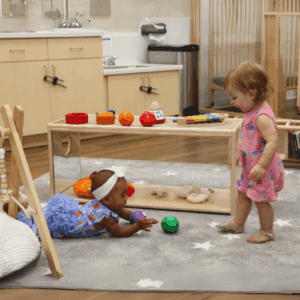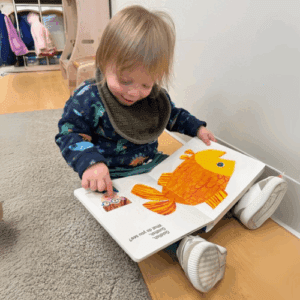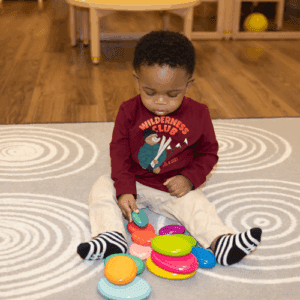As parents, we’re constantly navigating a maze of choices that shape our child’s development and well-being. One of those choices is deciding when to move from an infant mattress to a toddler mattress. It is more than a simple swap. This step can affect your child’s comfort, safety, and sleep quality.
Here, you will find practical advice and simple checkpoints that help you spot signs of readiness and prepare your child and their space. By the end, you will feel confident about the decision and the steps that follow, and you will have a plan that fits your family.
Quick Answer: Switching From an Infant Bed to a Toddler Bed
It is time to move from an infant to a toddler bed when your child starts climbing out of the crib, looks too big for it, or is around 18 months old. If you have a two-stage mattress, you can flip it from the infant side to the toddler side at around 12 months. Since every child develops at their own pace, consider individual milestones and ask your pediatrician if you are unsure.
Understanding Infant vs. Toddler Mattresses
Before you transition, it helps to understand what separates infant and toddler mattresses. Infant mattresses are intentionally firmer to support safe sleep and reduce SIDS risk. They fit snugly inside a crib to prevent gaps and keep tiny sleepers secure.
Toddler mattresses lean slightly softer to support growing bodies. Many options are dual sided, with a firm infant side and a gentler toddler side, so one mattress can serve both stages.
Key points to remember:
- Firmness: Infant mattresses are firmer for safety.
- Size: Most fit standard crib dimensions, but always check your crib and mattress compatibility.
- Dual-Sided Options: These extend the life of the mattress as your child grows.
Signs Your Child Is Ready for a Toddler Mattress
There is no single timeline that fits every child, but certain clues can guide you:
- Climbing Skills: If your little one starts climbing or attempting to climb the crib rails, consider a switch.
- Size Matters: If they look cramped, bump into the sides, or seem to run out of room, they may need more space.
Development also plays a part:
- Mobility and Restlessness: More rolling, scooting, or active sleep can signal readiness.
- Potty Training: If you are beginning this process, a toddler bed makes night trips easier.
Many families transition between 12 and 18 months, depending on whether they are just flipping a two-stage mattress or changing the bed out entirely. Still, the best timing is the one that fits your child. Watch for a mix of the signs above, and trust what you see day to day.
Safety Considerations During the Transition
Safety comes first as your child gains freedom in a new bed. Childproof the room so you can relax while they sleep.
Secure heavy furniture to the wall, and choose a toddler bed that sits low to the floor to reduce fall risk. Bed rails can add extra security during the early weeks.
Keep these tips in mind:
- Childproofing: Anchor dressers and bookshelves. Use outlet covers and cord keepers.
- Safety Rails: Add rails if your child tends to roll or if it helps them feel secure.
- Hazard-Free Zone: Remove small toys, curtain cords, and anything that could pose a choking or entanglement risk.
Preparing for the Transition
A little prep turns a big change into an easy win. Start by letting your child explore the new bed during the day. Curiosity and play make the space feel friendly before it becomes their main sleep spot.
Ease in with simple steps:
- Familiar Items: Use a favorite blanket or stuffed animal for comfort.
- Daytime Practice: Try short stretches of quiet play or a nap on the new mattress.
Keep bedtime steady. Consistent times, a calm routine, and positive encouragement make the new bed feel safe. Celebrate small wins, like a settled nap or a smooth bedtime, to build momentum.
Addressing Common Challenges
It is normal to see some resistance or bumpy nights at first. Stay patient and steady.
Try these approaches:
- Sleep Disruptions: Stick with your routine. Offer calm reassurance if they wake and guide them back to bed.
- Resistance: Keep the mood positive. Use simple choices, like which book to read, to give them a sense of control.
Revisit safety if needed. If your child still rolls a lot, rails or a soft mat beside the bed can help. Over a week or two, most children settle into the new rhythm.
Remember, you are both learning. Consistency and gentle support go a long way.
When to Seek Professional Advice
If the transition remains difficult after a steady effort, it can help to check in with a professional.
Consider reaching out if:
- Persistent Sleep Problems: Ongoing night wakings or bedtime battles begin to affect daily life.
- Health Concerns: Loud snoring, pauses in breathing, or other unusual patterns show up.
Final Thoughts on Switching From an Infant Mattress to a Toddler Mattress
Moving from an infant to a toddler mattress is a step forward, not a sprint. When you watch for readiness signs, create a safe room, and choose a supportive mattress, you set up calmer nights and brighter mornings.
Trust your instincts, and give the process time. Every child’s path looks a little different, and that is okay.
If you’re in Wilton, Shelton, or Trumbull, and need a daycare for your infant or toddler, get in touch!




